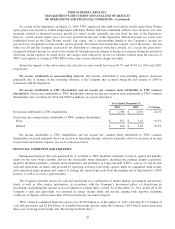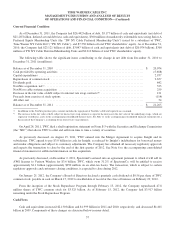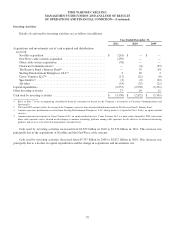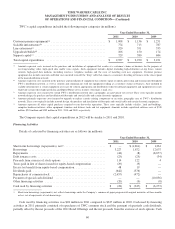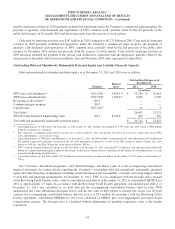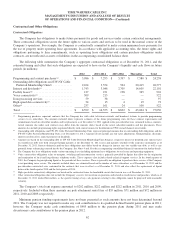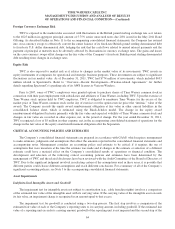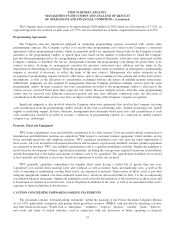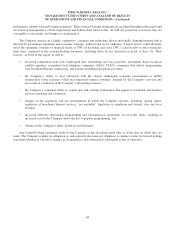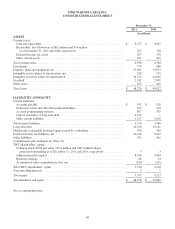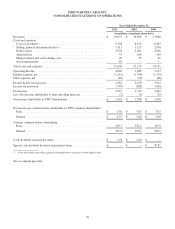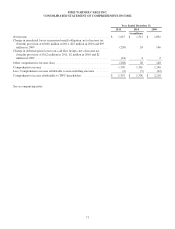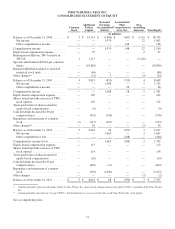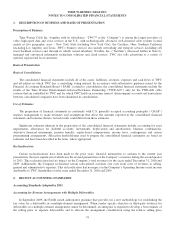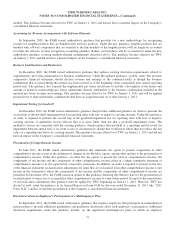Time Warner Cable 2011 Annual Report Download - page 73
Download and view the complete annual report
Please find page 73 of the 2011 Time Warner Cable annual report below. You can navigate through the pages in the report by either clicking on the pages listed below, or by using the keyword search tool below to find specific information within the annual report.TIME WARNER CABLE INC.
MANAGEMENT’S DISCUSSION AND ANALYSIS OF RESULTS
OF OPERATIONS AND FINANCIAL CONDITION—(Continued)
impairment test is not necessary. If the carrying amount of a reporting unit exceeds its estimated fair value, then the second
step of the goodwill impairment test must be performed. The second step of the goodwill impairment test compares the
implied fair value of the reporting unit’s goodwill with its goodwill carrying amount to measure the amount of impairment, if
any. The implied fair value of goodwill is determined in the same manner as the amount of goodwill recognized in a business
combination. In other words, the estimated fair value of the reporting unit is allocated to all of the assets and liabilities of that
unit (including any unrecognized intangible assets) as if the reporting unit had been acquired in a business combination and
the fair value of the reporting unit was the purchase price paid. If the carrying amount of the reporting unit’s goodwill
exceeds the implied fair value of that goodwill, an impairment charge is recognized in an amount equal to that excess.
As discussed further in Note 8 to the accompanying consolidated financial statements, the Company determined that
cable franchise rights and goodwill were not impaired during its annual impairment analysis as of July 1, 2011. The estimates
of fair value for the cable franchise rights were determined using a discounted cash flow (“DCF”) analysis. The DCF
methodology entailed identifying the projected discrete cash flows related to the cable franchise rights and discounting them
back to the valuation date. Significant judgments inherent in this analysis included the selection of appropriate discount rates,
estimating the amount and timing of future cash flows attributable to cable franchise rights and identification of appropriate
terminal growth rate assumptions. The discount rates used in the DCF analyses were intended to reflect the risk inherent in
the projected future cash flows generated by the respective intangible assets. To illustrate the extent that the fair value of the
cable franchise rights exceeded their carrying value as of July 1, 2011, had the fair values of each of the cable franchise
rights been lower by 20%, the Company still would not have recorded an impairment charge.
In performing the first step of the goodwill impairment test, the Company elected to carry forward the values ascribed to
its reporting units during its previous annual impairment test. The election to carry forward values was based upon
management’s determination, after reviewing events that have occurred and circumstances that have changed since the last
test, that the likelihood that the carrying amount of its reporting units exceeded their fair value was remote. Additionally,
under the previous test, the value of the Company’s reporting units significantly exceeded their carrying value. In making its
determination, management considered changes in all of the significant variables impacting the fair value of its reporting
units including, forecasted cash flows under its most recent long-range projections, changes in discount rates and changes in
terminal growth rate assumptions. A decline in the fair values of the reporting units by up to 30% would not have resulted in
any goodwill impairment charges as of July 1, 2011. As discussed in Note 6 to the accompanying consolidated financial
statements, the Company acquired NaviSite on April 21, 2011 and recorded goodwill of $142 million. As such, the estimated
fair value of NaviSite approximates its carrying value and a future decline in the estimated fair value would result in a
goodwill impairment.
Investments
TWC’s investments are primarily accounted for using the equity method of accounting. A subjective aspect of
accounting for investments involves determining whether an other-than-temporary decline in value of the investment has
been sustained. If it has been determined that an investment has sustained an other-than-temporary decline in its value, the
investment is written down to its fair value by a charge to earnings. This evaluation is dependent on the specific facts and
circumstances. TWC evaluates available information (e.g., budgets, business plans, financial statements, etc.) in addition to
quoted market prices, if any, in determining whether an other-than-temporary decline in value exists. Factors indicative of an
other-than-temporary decline include recurring operating losses, credit defaults and subsequent rounds of financing at an
amount below the cost basis of the Company’s investment. This list is not all-inclusive and the Company weighs all known
quantitative and qualitative factors in determining if an other-than-temporary decline in the value of an investment has
occurred. In 2011, there were no significant investment impairment charges. As discussed above in “Market Risk
Management—Equity Risk,” TWC’s most significant equity-method investment as of December 31, 2011 is SpectrumCo.
Refer to “Overview—Recent Developments—Wireless-related Agreements” for further details regarding SpectrumCo’s
pending sale of its AWS licenses to Verizon Wireless.
Income Taxes
From time to time, the Company engages in transactions in which the tax consequences may be subject to uncertainty.
Examples of such transactions include business acquisitions and dispositions, including dispositions designed to be tax free,
issues related to consideration paid or received, investments and certain financing transactions. Significant judgment is required
65



